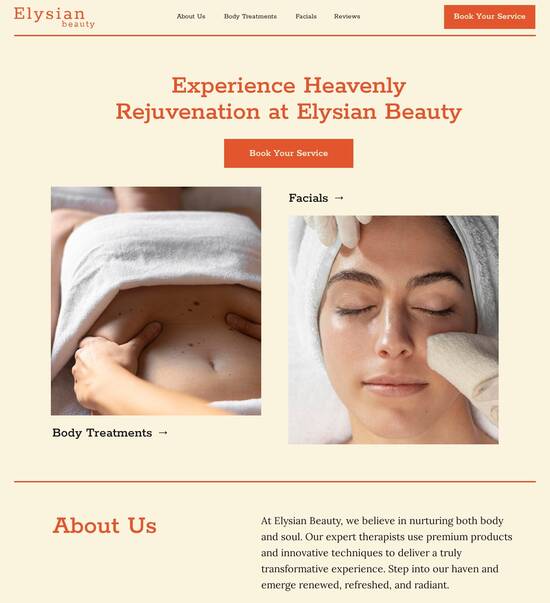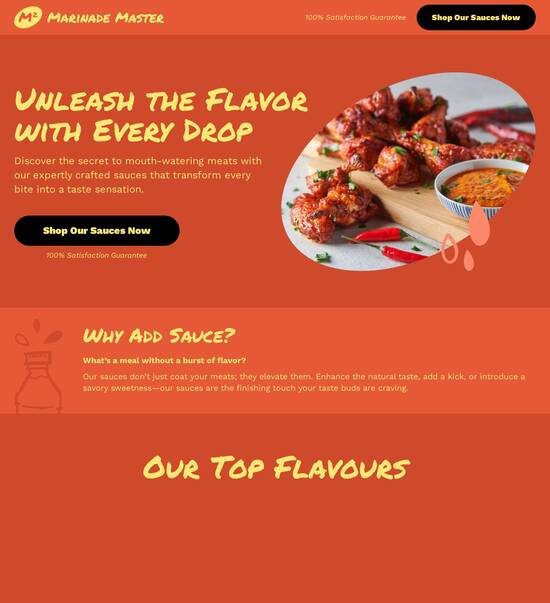
HTML page templates optimized for Dell XPS
Use TemplateAbout template
Transform your customer experience with HTML page templates optimized for Dell XPS. Make your landing page accessible on any device.
Recommended templates

Easy to build without coding
With the intuitive drag-and-drop builder, anyone on your team can create high-converting pages without any knowledge of code or design. Make enhancements to your landing page with custom widgets using Javascript, HTML/CSS, or third-party scripts.

Multiple layouts for any industry and goal
Select from 500+ landing page layouts built to boost conversions across industry-specific scenarios. Customize them by adjusting fonts, adding images, and generating on-brand content with the AI assistant. Quickly scale with Instablocks® and Global Blocks that you can save, reuse, and update globally.

Loads fast and looks polished on any device
Every template is responsive, which means they present professionally on any device and load blazingly fast with our Thor Render Engine. You can also power them up with Google AMP technology to deliver an unparalleled mobile experience and drive higher conversions.

Robust analytics & experimentation
Get real-time updates and reporting across all your devices, showing the number of visitors, conversions, cost-per-visitor, and cost-per-lead. Launch AI-powered experiments, run A/B tests, and use heatmaps to analyze user behavior, then optimize your landing page to maximize conversions.







Easy to build without coding
With the intuitive drag-and-drop builder, anyone on your team can create high-converting pages without any knowledge of code or design. Make enhancements to your landing page with custom widgets using Javascript, HTML/CSS, or third-party scripts.
Multiple layouts for any industry and goal
Select from 500+ landing page layouts built to boost conversions across industry-specific scenarios. Customize them by adjusting fonts, adding images, and generating on-brand content with the AI assistant. Quickly scale with Instablocks® and Global Blocks that you can save, reuse, and update globally.
Loads fast and looks polished on any device
Every template is responsive, which means they present professionally on any device and load blazingly fast with our Thor Render Engine.
Robust analytics & experimentation
Get real-time updates and reporting across all your devices, showing the number of visitors, conversions, cost-per-visitor, and cost-per-lead. Launch AI-powered experiments, run A/B tests, and use heatmaps to analyze user behavior, then optimize your landing page to maximize conversions.
All the features you need to build lead-generating landing pages
Explore more featuresLearn how to build top-performing landing pages for any goal
FAQs
Leading the way in building high-performing landing pages





Your step-by-step guide to optimizing landing pages with Instapage
Creating high-converting landing pages can significantly enhance your digital marketing efforts. Instapage offers a powerful landing page and conversion rate optimization (CRO) platform that equips marketers with all necessary tools to refine their campaigns effectively. This guide will walk you through the essential steps to maximize your investments and optimize your marketing strategies using Instapage.
Understanding the importance of landing pages
Landing pages serve as critical touchpoints in your marketing funnel. They are designed to capture leads, convert visitors into customers, and directly influence your return on investment. Instapage simplifies the page creation process, enabling marketers in various industries, such as education, financial services, and tech, to develop tailored landing pages that resonate with their target audiences. Here are some key aspects of effective landing pages:
- Relevance: The landing page must reflect the promise made in your ads.
- Clarity: Concise messaging and clear calls-to-action (CTAs) improve conversion rates.
- Visual Appeal: Well-designed layouts attract attention and encourage interaction.
Step 1: Choosing the right template
Instapage provides over 100 ready-to-use templates tailored for effective lead generation. Selecting the most relevant template is vital for effectively communicating your value proposition. Follow these steps to make the right choice:
- Identify your goal: Determine whether you're collecting leads, promoting a product, or offering a service.
- Choose a customizable template: Instapage's templates are designed for easy modifications, allowing you to reflect your brand identity.
- Consider your audience: Tailor designs to appeal to specific demographics within your target sectors, such as business services or government.
Step 2: Implementing personalization tactics
Personalization is a critical factor in increasing landing page effectiveness. Instapage offers advanced personalization features that can dynamically change content based on user behavior. To leverage this, consider:
- Dynamic Text Replacement: Adjust messaging to match user queries or ad copy.
- AdMaps: Align unique advertisements with distinct landing pages for better relevancy.
- Audience-specific metrics: Utilize Instapage's data tools to gauge what works best for each segment.
Step 3: Optimizing and analyzing performance
Optimization does not end with page creation; it's an ongoing process. Use Instapage's built-in experimentation features to conduct A/B testing on different elements. Key activities include:
- Heatmaps: Analyze user interaction to understand behavior and refine designs.
- Regular A/B testing: Experiment with variations of page elements to identify high-performing combinations.
- Analytics dashboard: Evaluate overall performance metrics and adjust strategies as needed.
Incorporating these steps can drastically enhance the effectiveness of your campaigns. With Instapage's robust tools, marketers can optimize their landing page strategies to achieve superior results.
Ready to transform your marketing campaigns? Start using Instapage today to build landing pages that captivate and convert. Optimize your efforts and realize the full potential of your digital marketing strategy!
People also ask about HTML page template optimized for Dell XPS
HTML page template optimized for Dell XPS
Understanding the Dell XPS landscape
The Dell XPS line has established itself as a favorite among users seeking high performance and sleek design. Its lineage showcases a consistent evolution aimed at delivering cutting-edge technology. This has made the XPS series particularly attractive to professionals in various fields, from creative to corporate. With innovative features and robust specifications, Dell XPS caters to those who need reliability and aesthetics in their gadgets.
One standout feature of the Dell XPS is its screen, which often includes 4K resolution and the InfinityEdge display. These qualities provide a stunning visual experience, beneficial for web designs that require color accuracy and high detail. A designer or marketer using a Dell XPS will benefit enormously from this capability, which allows them to create visually pleasing content. Coupled with technology that enhances color reproduction, it’s a match made for creative professionals.
High-quality display options allow for unparalleled visual clarity.
Improved color accuracy ensures that designs are displayed as intended.
Performance specifications support seamless multitasking.
Dell XPS laptops also come with powerful hardware configurations that directly impact performance for tasks such as web development. With options for high RAM and storage capacities, users can expect smoother workflows that are especially beneficial when managing multiple tabs, intricate designs, or large media files.
HTML essentials for optimized page templates
In any web development project, understanding the fundamentals of HTML is crucial. The oft-cited structure of an HTML document involves elements like doctype, html, head, and body tags. Each serves a specific purpose, ensuring that the browser accurately interprets the web content. Semantic HTML is particularly important as it fosters a better user experience, allowing search engines and assistive technologies to understand the webpage's context.
Modern HTML practices have evolved significantly, particularly with the introduction of HTML5. This version brings enhanced features such as canvas for rendering graphics, video support for multimedia, and local storage capabilities. Understanding these advancements is essential for creating responsive designs that look good on Dell XPS devices and accommodate diverse user needs.
Utilize semantic elements to improve accessibility and SEO.
Incorporate multimedia features for engaging content.
Focus on responsive design practices to enhance mobile usability.
Crafting the optimal HTML page template
When structuring an HTML template, it is critical to utilize the header, main, and footer elements effectively. The header generally contains the navigation and branding elements, while the main encompasses the core content of the page. On the other hand, the footer is typically reserved for contact information, copyright notices, or links to privacy policies. Paying attention to these details ensures a clean and user-friendly layout.
Another vital aspect is ensuring mobile responsiveness. This is increasingly important given the variety of devices used to access web content. Using CSS Grid and Flexbox aids in creating flexible layouts that adapt to screen sizes. Integrating JavaScript can add an additional layer of interactivity, making the user experience more engaging and dynamic.
Using CSS for layout adjustments enhances visual appeal.
Implementing JavaScript can create smooth transitions and interactive elements.
Attention to load times is crucial; consider lazy loading images for better performance.
To reach optimal page performance, minimizing HTML file size is key. Reducing unnecessary code through techniques like minification can lead to faster load times. Additionally, employing image compression and lazy loading techniques can also significantly improve user experience, especially on high-resolution screens like that of the Dell XPS.
Tailoring content to Dell XPS users
Understanding the user personas that utilize Dell XPS laptops allows for creating content that directly appeals to them. Dell XPS serves a variety of communities, including students, professionals in tech, marketing, and design fields among others. Gathering feedback from these groups and recognizing their specific needs can inform content creation that resonates with them.
Highlighting Dell XPS features, such as multitasking capabilities and superior display, can further engage users. For instance, leveraging their hardware capacity for video editing or complex data analysis can show users the practical benefits of using such a device and enhance their productivity.
Identify the different teams that utilize Dell XPS for tailored content creation.
Use customer feedback to continuously refine content strategies.
Showcase features that enhance productivity and creativity through hands-on examples.
Solving common problems through design
Even the most carefully planned HTML page templates may encounter common issues on Dell XPS. Rendering problems can occur based on different browsers interpreting CSS and HTML differently. Being aware of these quirks and testing across devices ensures that your content displays as intended. Additionally, with varied screen resolutions, designing adaptable templates becomes paramount.
Utilizing media queries is an effective method for tackling these issues, allowing for tailored styles based on specific device characteristics. Furthermore, designing for various screen sizes encourages user interaction by ensuring that all elements are accessible and easy to engage with, regardless of the device.
Test templates for browser compatibility to avoid rendering issues.
Employ media queries to adapt page styles to various devices.
Ensure all interactive elements are easy to use across different viewports.
Best practices for accessing community feedback
Engaging with user collectives in the Dell XPS community can provide invaluable insights. Utilizing surveys and community forums allows marketers and designers to gauge the effectiveness of their templates. Sourcing feedback from actual users is a strategy that offers real-world perspectives on how well designs cater to their needs.
Analyzing user behavior through website analytics tools can provide deeper insights into which aspects of a web page are performing well and which aren't. Observing metrics such as bounce rates, time on page, and click-through rates can guide adjustments and refinements to improve overall engagement.
Implementation of surveys can capture direct feedback from users.
Utilize community forums to foster discussions around usability.
Employ analytic tools to track user interactions and behaviors.
Future-proofing HTML templates
As web technology continually evolves, embracing innovative technologies is essential for staying relevant. Integrating AI and machine learning features can help create more personalized web experiences, allowing content to adapt to specific user needs. Awareness of the emergence of Web3 and decentralization further highlights the need for templates that can accommodate future shifts in how people interact with digital content.
Staying updated on advancements in HTML and CSS is equally critical. Regularly absorbing information from industry blogs, online courses, and community discussions can keep developers informed about best practices and emerging trends. By proactively learning and adapting to these changes, developers can ensure their HTML templates remain effective and relevant.
Explore AI technologies to enhance user personalization.
Stay informed on developments in web technologies and frameworks.
Engage with community discussions to exchange knowledge and practices.
Case studies and real-world applications
Examining real-world applications of HTML templates shows the successful integration with Dell XPS devices across different industries. Organizations in sectors like education, marketing, and financial services have leveraged these templates to create engaging landing pages. For instance, marketing agencies have effectively utilized responsive designs to present their offers attractively, which in turn has captured higher conversions.
Additionally, these case studies provide lessons about design failures and successes. Understanding what works and what doesn’t paves the way for continuous improvement in template creations. It showcases innovative strategies that resonate with end-users and create engaging experiences.
Highlight successes in specific industries utilizing HTML templates.
Analyze case studies to extract lessons on user engagement.
Showcase innovative designs that lead to increased conversions.
Creating a compelling argument for HTML page templates
Design plays a critical role in user engagement, as people often form an impression based on their initial visual interactions with a webpage. Effective design should marry both usability and aesthetics, ensuring that engaging content works harmoniously with a functional layout. Thus, the challenge is to strike a balance where users can both admire and easily navigate the website.
Demonstrating return on investment through optimization efforts is essential for justifying design decisions. Measurement metrics like conversion rates, bounce rates, and user engagement show how effective a template is in meeting objectives. By continually tracking these metrics, marketers can highlight long-term benefits derived from strategic design choices.
Showcase design enhancements through user engagement metrics.
Employ analytics to trace conversions and user interactions.
Communicate how effective design contributes to overarching business goals.
Conclusions drawn from exploration
Throughout the exploration of HTML templates optimized for Dell XPS, key insights emerge about user needs, design practices, and ongoing changes in technology. Developers and designers alike can benefit from a deeper understanding of how specific features target the Dell XPS user base effectively, providing an enhanced experience that keeps users engaged.
As technology continues to evolve, so too will the expectations of users. Staying ahead of these trends allows for the development of templates that not only meet today’s demands but also future-proof against the changes that lie ahead. The ultimate goal is to create intuitive, engaging, and effective web experiences that encourage user interaction and satisfaction.
Foster a thorough understanding of user needs and behaviors.
Emphasize the importance of adaptability in web design.
Invest in continuous learning to remain relevant in web development practices.
Ready to skyrocket conversions?
Supercharge your ad campaigns with high-performing landing pages
Get started














